Signs of a Cockroach Infestation
By Kevin Thorn • Sep 15th 2021
Before we get into the signs of a cockroach infestation, it is important for us to identify the common cockroaches in Utah and which of them typically infest homes, apartments, and restaurants.
There are three main species of cockroaches in Utah; the German cockroach, the oriental cockroach, and the American cockroach. We also have brown banded cockroaches here in Utah, another cockroach that can be a pest, but they're not common. Correct identification is important because each cockroach species has unique behaviors and biology and so it's helpful to know what you are dealing with.
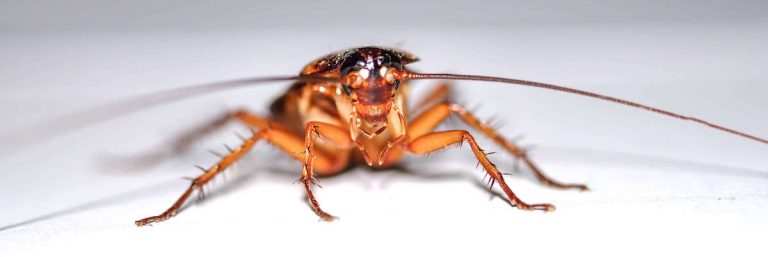
Common Cockroach Identification
German Cockroaches
This is the cockroach that we are typically most concerned with. It is a smaller cockroach that infests structures and can be difficult to eliminate. These cockroaches are domestic meaning that they only live indoors. They do not enter building from the outside but instead are brought in or come from adjacent parts of a building. German cockroaches are the most common pest cockroach and develop large numbers in a short amount of time.
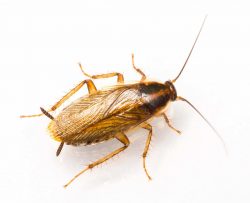
German cockroaches are about 1/2 inch long, they are light brown in color, and have two dark stripes behind the head. Adult males and females have wings but they cannot fly. Juveniles are smaller, darker, and don't have wings.
Oriental Cockroaches
Oriental cockroaches are larger than the german cockroach and are dark brown to black in color. Their wings are absent or are not as long as the body. These cockroaches are peridomestic meaning that they live outside and inside of structures. These cockroaches seek out damp and cool locations. Oriental cockroaches are common under leaf litter, mulch, sewers, basements, and drains.
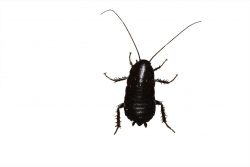
American Cockroaches
The american cockroach is a larger species of pest cockroach that is usually only found in southern Utah around the St George area. This species of cockroach also lives indoors and outdoors. They are the largest cockroach species found in Utah and can be up to 2 inches long. They are reddish brown with a lighter boarder around the head. Adult american cockroaches have wings that run the length of their body. Immature american cockroaches have no wings.
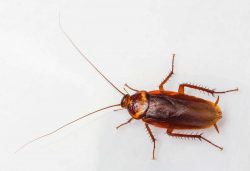
So What Are the Signs of a German Cockroach Infestation?
German cockroaches are the most common pest cockroach in the world and are the most problematic, and should not be tolerated in homes and restaurants. This is the cockroach we are typically trying to find when looking for a cockroach infestation of here in Utah. They live indoors and quickly infest.
Fecal Spotting
The first thing you could look for to locate a cockroach infestation is fecal spotting. Cockroaches deposit a granular feces in places where they like to aggregate. This is often close to food, water, and heat. Kitchens and bathrooms are prime locations for German cockroaches. Look under the sink in the upper corners of the cabinet, under the lip of the countertop, behind the refrigerator and in the electrical panel. These are German cockroach hot spots. If you see back spotting (and are feeling brave) you can touch the feces. They kind of feel like grains of pepper.
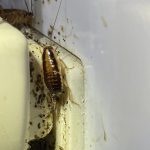
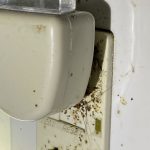
Dead Cockroaches
Finding dead cockroaches is a sign of a current or recent infestation. When finding dead cockroaches but nothing alive, we recommend placing glue board monitors. These "sticky traps" can be the most effective method to tell whether there are still live cockroaches present. We recommend placing the glue board where cockroaches are most commonly found like under the sink, in kitchen cabinets, behind the stove, behind the refrigerator, and in the bathroom. You can check these as frequently as you like but we recommend at least weekly. If you do not catch cockroaches in the traps in over a month, you can be fairly confident that there are no cockroaches present.
Egg Capsules
Adult female cockroaches create egg capsules. German cockroach egg capsules hold between 24-48 baby german cockroaches inside. A female german cockroach carries this egg capsule with her at the end of her abdomen until they are ready to hatch. This takes about 28 days. Often when looking for an infestation you can find a few of these capsules in kitchen cabinets and drawers. Egg capsules are light brown in color, about 1/3 of an inch long, and have 16 segments.
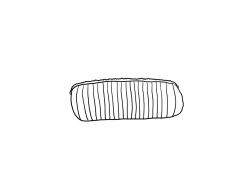
Live Cockroaches
Obviously you should also be on the look out for live german cockroaches. These cockroaches like to be in cracks and crevices where they feel protected and they also shy away from the light. This behavior of shying away from light is called being negatively phototrophic. If looking during the day with all the lights on, you will need to look where cockroaches tend to hide. Again this is close to warmth, water, and food. Try pulling out the refrigerator and looking for live cockroaches. Look under cabinets and look at the top corners near where the sink mounts. Keep an eye out for straight antennae poking out from cracks and crevices.
Occasionally German cockroaches can be found in areas not generally suspected of harboring cockroaches like closets, bedrooms, or dressers. Usually this is a sign of stress, a heavy infestation, or repellent pesticides being applied. Seeing cockroaches during the middle of the day out in the open is another sign of a heavy infestation or stress.
What is an Infestation?There could possibly be some debate on this topic but from our perspective, when dealing with german cockroaches one is too many. German cockroaches are very prolific and quickly grow in numbers. When dealing with german cockroaches it's generally necessary to eliminate 100% of the cockroaches to get "control". If populations are simply reduced to small numbers they will rebound and the issue will not be resolved.
How Do You Get a German Cockroach Infestation?German cockroaches do not come from the outside. They must be brought in or come from an adjacent area of a building. German cockroaches can be brought in on items like food packaging, used furniture, or even employee lunches or belongings.
What Should I Do if I Have an Infestation of German Cockroaches?
German cockroaches are difficult to eliminate and usually require an expert pest professional. Foggers should never be utilized and will often make things worse. These "push" cockroaches around and the fog doesn't get into the cracks and crevices where the cockroaches live.
Sprays are almost always a bad idea too. Again these tend to "push" cockroaches around into difficult to treat areas and when not utilized correctly they typically lead to poor results.

If you want to help and start eliminating cockroaches today, we suggest placing glue boards down in the kitchen, bathroom, and anywhere cockroaches are being seen. Glue boards can capture a lot of cockroaches. We recommend placing glue boards under the sink, behind the stove, behind the refrigerator, and anywhere you have seen cockroaches.
Call a ProfessionalGerman cockroach elimination is tough. There is a reason they are the number one pest cockroach in the world. They have a high reproductive capacity, females carry their egg capsules with them, they are small, and they are resistant to many modern pesticides. When hiring a professional ask lots of questions. Find out if the person answering the phone is knowledgeable and can walk you through the treatment process.
Some possible questions to ask:
- What is your treatment process?
- How many treatments will it take? (Hint: It will take more than one. Usually 3-5 treatments)
- How will you confirm elimination?
- How will you be monitoring your progress?
- What materials will you be using?
- What if any preparation is needed? (We recommend little to no preparation.)
- If you live in an apartment we strongly encourage you to report German cockroaches to your landlord or management. Cockroaches can spread quickly in apartments.
While we can still eliminate cockroaches when kitchens and other areas are not clean, it can make it more difficult. It can mean more treatments, more time, more bait, and more money you have to spend. Try to clean up food spills. Take out garbage regularly. Clean behind the refrigerator and stove. And don't leave dirty dishes in the sink overnight.
Don't leave pet food outPet food is a preferred food of cockroaches. If you are dealing with an infestation, we recommend feeding your pet and then removing any uneaten food in the evening.
German cockroaches are the number one cockroach pest in the world and they are not fun to have to live or deal with. It is important to know the signs of German cockroach infestations so that you can avoid them or catch an infestation early when it is easier to eliminate .
About Thorn
Thorn is a Utah local pest management company. We are a QualityPro certified company which is a prestigious accreditation awarded to less than 3% of the pest management companies in the US.
Resources
About Thorn
Thorn is a Utah local pest management company. We are a QualityPro certified company which is a prestigious accreditation awarded to less than 3% of the pest management companies in the US.